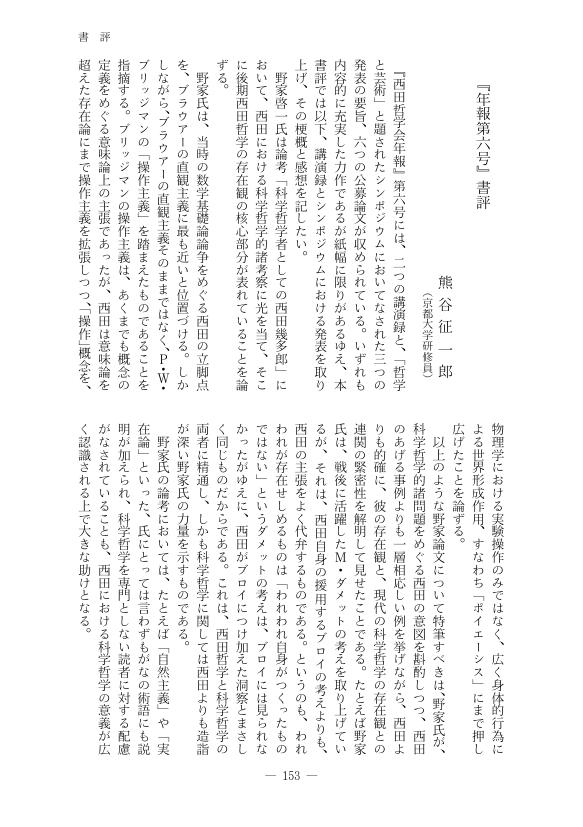1 0 0 0 OA 「無からの創造」と「潜在からの顕現」との両否定 西田とヘーゲル
- 著者
- 熊谷 征一郎
- 出版者
- 西田哲学会
- 雑誌
- 西田哲学会年報 (ISSN:21881995)
- 巻号頁・発行日
- vol.14, pp.85-99, 2017 (Released:2020-03-21)
Both Nishida and Hegel see the occurrence of something from the viewpoint of‘energeia and dynamis’.In this paper, we try to clarify their theory and consider their relation and difference. Hegel generally sees the occurrence of something as change from energeia to dynamis. He thinks our activity derives something which exists in itself from condition. In A Study of Good, Nishida sees product of act as actualization of potential inspiration and formulates form of activity of consciousness as differentiation and development of potential totality. We can see Hegel’s influence on Nishida’s thought above. However, after the book, we can see change in Nishida’s thought. That is to say, in the later Nishida, he negates either actualization of potentiality or creation from nothing and consists paradox that something comes from the former world spontaneously while activity of finding it out changes it. Hegel’s theory has tendency of a kind of determinism. On the other hand, Nishida’s theory permits various possibilities of new occurrence and allows creativity and individuality of our activity which takes part in determination of new occurrence. As for our action, Hegel sees it as actualization of our potential talent and character and as change of form from dynamis to energeia whereas Nishida thinks that product of act cultivates our talent and character.
1 0 0 0 OA 書評 檜垣立哉著『日本哲学原論序説 ― 拡散する京都学派』
- 著者
- 熊谷 征一郎
- 出版者
- 西田哲学会
- 雑誌
- 西田哲学会年報 (ISSN:21881995)
- 巻号頁・発行日
- vol.13, pp.154-157, 2016 (Released:2020-03-21)
1 0 0 0 OA 『年報第六号』書評
- 著者
- 熊谷 征一郎
- 出版者
- 西田哲学会
- 雑誌
- 西田哲学会年報 (ISSN:21881995)
- 巻号頁・発行日
- vol.7, pp.153-156, 2010 (Released:2020-03-23)
1 0 0 0 OA 悲哀における自覚 西田哲学において
- 著者
- 熊谷 征一郎
- 出版者
- 西田哲学会
- 雑誌
- 西田哲学会年報 (ISSN:21881995)
- 巻号頁・発行日
- vol.3, pp.103-116, 2006 (Released:2021-01-16)
It is well-known that Nishida Kitaro asserted the motive of philosophy must be the grief of life. In early literature, the grief of life has been often dealt with in terms of the Nishida's life. It is true that his life was not a little unhappy and grief was his motive of philosophy. However, the grief of life is important not only in his life, but also in the system of his philosophy. Even when the grief of life was dealt with in terms of the system of philosophy in early literature, it was treated in the context of emotion. But it is more essential in the context of selfrealization. In short, he thinks that self is realized as place of nothingness and as the unique person in the grief of life. He finds a sort of contradiction in selfrealization. Or rather, he thinks of self as the contradiction itself. He finds two aspects in the contradiction. One is that self is intuited when it gets lost and subsumes objects .. That means the fundamental acquisition of the body and the self-realization as subsuming place of nothingness. The other aspect of the contradiction is the coincidence of the realization of the eternal death and that of the uniqueness of self. In both aspects, the negation of the grief plays essential roles.
1 0 0 0 OA 西田他者論における転回 共感的一致から応答的結びつきへ
- 著者
- 熊谷 征一郎
- 出版者
- 西田哲学会
- 雑誌
- 西田哲学会年報 (ISSN:21881995)
- 巻号頁・発行日
- vol.2, pp.128-142, 2005 (Released:2021-01-16)
The Turn in Nishida's Philosophy of Others Nishida's philosophy of others has been often criticized for identifying self with others. Especially, his paper I and You has been. However, exactly in the paper, Nishida's philosophy of others takes a 180 degree turn. It is, as it were, the turn from sympathetic identification to response relations with others. Therefore, concerning after the paper, the criticisms are beside the point, even though they are right to the point before the paper. In this thesis, I make clear the substance and tracks of the turn. But, the criticisms seem to have the grounds even in the paper. In fact, the paper has a lot of words which suggest that he identifies self with others. However, if you examine the true meaning of those words faithfully, you find that they mean diverse sides of response relations. In short, he finds immediate encounter with others not in the direction of sympathy or empathy, but in the direction of birth of Itself. It is well-known that Nishida uses the concept of he. I prove that Nishida thinks the response relations between self and others can be realized only where they are open to him (a third party)

